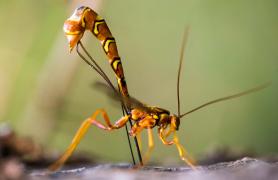Strap on your mask and snorkel! It’s time to explore a cool pool in a clear Ozark stream.
Take a Closer Look
If you’re snorkeling and spot a slight movement in the gravel or a tiny puff of sand, don’t move a muscle — it might be a mussel. The clamlike animals lie half-buried at the bottoms of streams. If you touch a live mussel, it will think you are a predator and quickly clamp its shells shut.
Look
Peer into a pool, and you’ll be amazed at the rainbow of fish you find. Minnows, shiners, and darters of every color often school in the calm water behind boulders. How many of these fintastically flashy fish can you find?
Listen
When startled, female wood ducks squeal. If you surprise one while exploring a stream, listen for her shrill ooheek, ooh-eek, ooh-eek call as she flies away.
Do More
When exploring a stream, bring along a trash bag so you can pick up litter you see.
Take a Closer Look
Inspect the rocks in a swift-flowing stream, and you may find some pennies. But they aren’t the kind you can spend. Water pennies are flat, copper-colored baby insects. They cling to rocks and feed on algae and microscopic creatures.
Did You Know?
Water pennies are baby beetles. They live underwater as larvae but breathe air as adults. Finding a water penny is a good sign. It means the water is clear and clean.
Look
Fishing spiders are so light they can walk on water! Sometimes they sail across the surface by lifting up two legs to catch the wind. They gather air bubbles on their hairy legs. This allows them to stay underwater for half an hour. Search the shoreline for these amazing arachnids.
Missouri’s most common swimming serpent — the northern watersnake — is harmless, but people often confuse it with the rarer but venomous western cottonmouth. Here’s how to tell them apart.
Northern Water Snake
- Harmless (but sometimes bitey)
- Gray to reddish-brown body with brown, reddishbrown, or blackish bands
- Round pupils
- If threatened, will try to flee
Western cottonmouth
- Venomous (and sometimes cranky)
- Dark olive-brown to nearly black body with dark bands that are often hard to see
- Head usually has a black stripe running from the snout to the neck
- Vertical pupils (like a cat’s)
- Swims with its head above the water’s surface, exposing its back
- If threatened, may hold its ground and show its fangs and cottony mouth
Also In This Issue


This Issue's Staff
Les Fortenberry
Karen Hudson
Angie Daly Morfeld
Noppadol Paothong
Marci Porter
Mark Raithel
Laura Scheuler
Matt Seek
David Stonner
Nichole LeClair Terrill
Stephanie Thurber
Cliff White






















